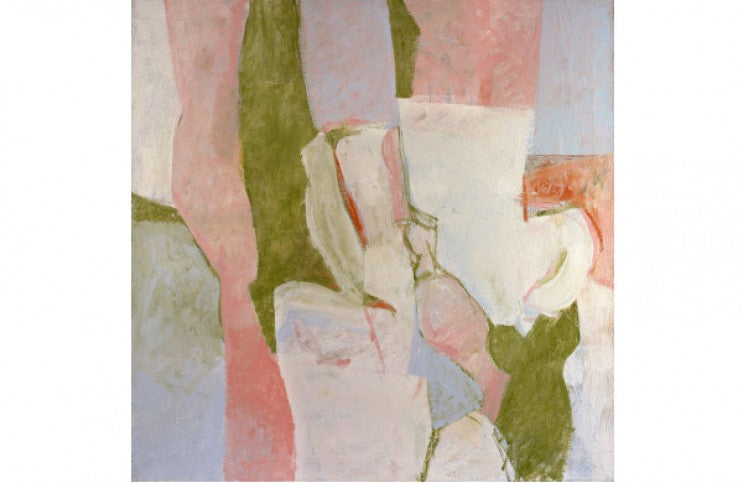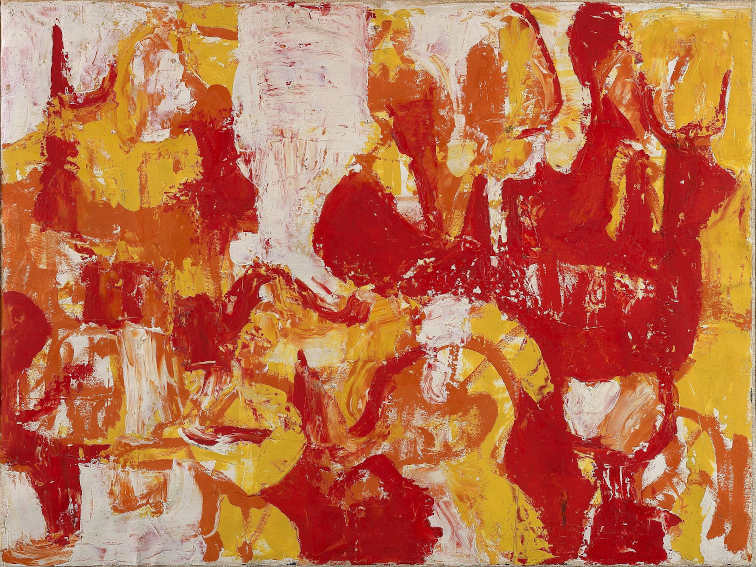
Charlotte Park, An Abstract Artist To Know
I find familiar things in the work of Charlotte Park. I see in her paintings an almost boundless anxiety and searching, replaced in certain moments by a quietude or stillness, but always confident. Park is not a particularly well-known artist today, although her closest associates are among the most famous artists of the past century. She was married to James Brooks, whose work is in the Tate, MoMA and the Smithsonian, among other institutional collections. Park and Brooks lived next door to Jackson Pollock and Lee Krasner in New York City. When Pollock and Krasner moved to the Hamptons, Park and Brooks took over their apartment, then later followed them out to Long Island. Despite being surrounded socially by dozens of other talented painters, Park developed a singular visual voice that to me is instantly relatable. Perhaps she is relatively unknown today compared to her contemporaries because they were all gleefully associated with Abstract Expressionism. Although many contemporary art writers and dealers have made overt attempts to “re-discover” Park, and to force her work into that same historical context, I feel no inclination to write about Park as part of that movement, or tendency, or phenomenon, or whatever it was or is. Park seems to me to have been on a personal artistic journey, one which followed a unique evolution. Unlike so many of her cohorts, who achieved critical success and then ossified, Park attained her peak late in her career, like a wise sage who at last makes it to the top of a mountain, seeing everything, finally, in the tiniest thing. Whereas Abstract Expressionism always seems to me to be about a sort of “me-ness,” Park created a body of work that feels more about “all-ness.” Her paintings not only map her individuality, but her humanity—her evolution from searcher to inner peace.
A Figure in Isolation
Born in Concord, Massachusetts in 1918, Park earned her art degree from Yale in 1939. She worked for the Office of Strategic Services (OSS), which later became the CIA, during World War II, then moved to New York with Brooks after the war. In Post-War Manhattan, she and Brooks found themselves in the midst of one of the most vibrant artistic avant-gardes in the world. Yet, the only aspect of that scene that seems to have permeated the work Park made at that time is the focus on abstraction. Her paintings betray little interest in the main concerns of her contemporaries, such as subconscious, automatic drawing, transcendentalism or myth-making. Park does not appear to have seen herself, as Pollock did, as nature incarnate. She instead painted like an artist interested in asking fundamental questions about what painting is, and whether it is really suitable for expressing the totality of the human experience.

Charlotte Park - The Sun, 1950. Oil on paper mounted on canvas. 18 x 24 in. (45.7 x 61 cm). © Berry Campbell Gallery
Early paintings like “Masque” (1950), “The Sun” (1950), and “Departure” (1955), suggest someone who is seemingly trying to paint crowds—huddled, biomorphic forms caught in a game of push and pull. The forms themselves in these paintings are not really the subject matter. It is rather the relationships between them and their environment that feels important. In an extended series of mostly black paintings she started making in the 1950s, Park seemed to be trying to rip through plastic realities to discover something behind the surface. Anger and frustration feels embedded within these rough-shod visual outbursts. Emotion, allegory and metaphor are trying to express themselves, but the paintings seem almost inadequate to carry their messages. The one declaration that these paintings do succeed in making over and over again is that whoever painted them feels alone.

Charlotte Park - Untitled, 1985. Acrylic on paper. 28.6 x 28.6 cm. © James Brooks and Charlotte Park Foundation. Courtesy Berry Campbell Gallery
Finding the Grid
Some writers resist the call to tell stories, as odd as that may sound. They simply want to write, without structure, without expectations. Story can be a cage that robs the writer of many creative liberties. Some painters feel the same way about the grid. Having to create so-called compositions that adhere to existing visual formats is a source of real frustration to an artist who just wants to paint. The anxiety present in her work throughout most of her career suggests Park was intimately familiar with this struggle. Throughout the 1950s and 60s, and into the early 70s, her work rages against the boundaries of the frame, scuttling the influence of the grid, rejecting traditional notions of harmony and balance, and ignoring notions of the “all over” compositional strategy embraced by many of her contemporaries. Many of the paintings she made in this first half of her career do not really feel to me like paintings at all—they feel like fights: fights with space; fights with light; fights with materiality; fights with what the Polynesians call mana: the energy that collects in all things.

Charlotte Park - Pereshia, 1976. Acrylic on canvas. 18 x 18 in. (45.7 x 45.7 cm). © Berry Campbell Gallery
Park put energy into her paintings. She transferred something animate from herself, or of herself, into an inanimate thing, a picture. That fight came to an abrupt end, however, around the mid-1970s, when Park took a foray into an unexpected aesthetic sidetrack—that of Piet Mondrian and the heritage of Neo-Plasticism. Paintings like “Gerardia” (1975), “Hellebore” (1975-77) and “Pereshia” (1976-78) pick up right around where the simplified, Neo-Plastic color palette and grid structure of Mondrian left off. Except Park does it all free-hand, and with a free mind. Her phase of Neo-Plastic grid painting was short lived, but the idea of the grid remained present in her work for the rest of her career. It is as if rather than struggling with the limitations of the frame and the anti-liberalism of compositional structure, Park unexpectedly found some secret freedom in her embrace of such parameters. Her paintings were always confident, but the late appearance of the grid in them made them quiet and still. I personally relate to these peaceful paintings least of all among her oeuvre, but I wager my opinion would mean nothing to Park, since she was a rare artist who painted mainly for herself.
Featured image: Charlotte Park - Untitled, 1960. Oil on canvas. 34 x 34 in. (86.4 x 86.4 cm). © Berry Campbell Gallery
All images used for illustrative purposes only
By Phillip Barcio






